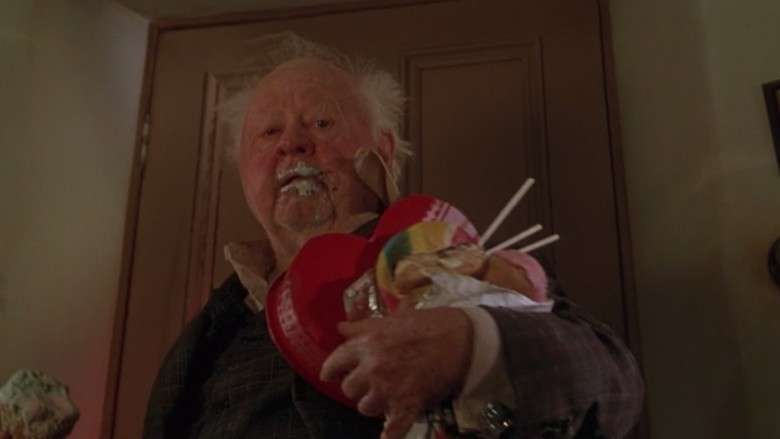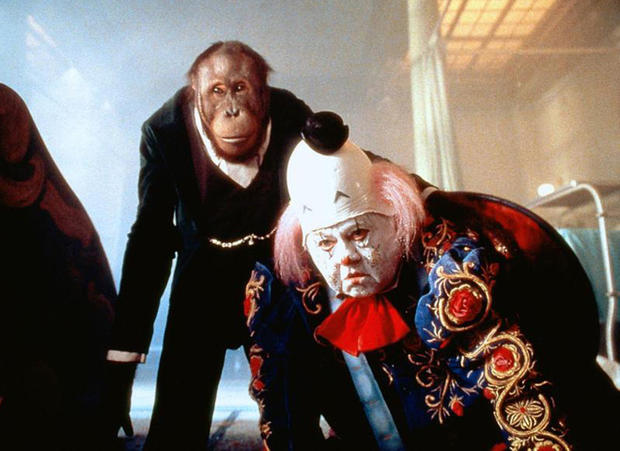Control Nathan Rabin #58 Babe: Pig in the City (1998)
This is a whole mood!
Perhaps the most striking and surprising frame in George Miller’s brilliant 1998 mind-fuck Babe: Pig in the City, a dark masterpiece overflowing with striking and surprising imagery and tableaus, happens before the film even begins. It’s the MPAA note that the movie that we are about to see has been rated G. Consequently all ages are permitted, and there is supposed to be no content inappropriate for children.
This raises some questions. How in the ever loving fuck did a movie as brutal and uncompromising in its unrelenting darkness as Babe: Pig in the City get the softest, most family-friendly rating imaginable? Did the person who rated the film G actually see the movie, or did the studio get him blackout drunk and then slapped the Babe: Pig in the City title card on an old print of Babe in an apparently successful attempt to deceive him? Did 70 million dollars of the movie’s 90 million dollar budget go towards paying off the MPAA to give the film a staggeringly inappropriate rating? Did the MPAA not notice that Pig in the City is essentially nothing but content inappropriate for children?
Or is possible that the person who deemed this walking nightmare from the bowels of hell fun for the whole family is actually a Grinch-like child-hater who wanted to traumatize and unnerve as many unsuspecting children as possible by giving the big-budget, high-profile follow-up to an Oscar-nominated sleeper hit children’s film a rating that would deceive parents into taking their offspring to something that would fuck their shit up but good with its depiction of the universe as a shadowy, brutal realm of unending pain, death and loss?
In the decades before I became a father, I prized nothing in a children’s movie more than being none too furtively adult and wildly inappropriate, even traumatizing, to small children. I was of the mindset that children’s movies are for cynical, irreverent adults, not children. Children could only fuck up kid’s movies with their juvenile demand for sticky-sweet songs and scatological humor and rank sentimentality.
As you might imagine, Babe: Pig in the City was my shit. I loved how subversively and completely it upended commercial considerations and audience expectations by transforming a gentle, lyrical, lovely little movie about a charming pig’s tender bond with his laconic but loving farmer “boss” into a darkly funny, weirdly funereal dystopian exploration of the universe’s unfathomable cruelty and the casual sadism of life in the big city.
With Pig in the City, Miller shifted gears ever so slightly from Disney Down Under to David Lynch makes a movie about talking animals. I was inspired to re-watch this box-office bomb turned beloved cult classic when a patron chose it and its predecessor, 1995’s Babe, for a special Father’s Day deal I was running for Control Nathan Rabin 4.0, the column where I gave YOU, the generous, kind-hearted and curious Nathan Rabin’s Happy Place patron, an opportunity to choose a movie I must watch and then write about in exchange for a one time, one hundred dollar donation to the site’s Patreon account. The price goes down to seventy-five dollars for each subsequent entry.
I’ve been publishing these pieces about once a week. It’s been a steady clip but I’ve got a bit of a backlog, thank God, so I’m planning on doubling up in the weeks or months ahead, in part because you wonderful freaks have given me so many fascinating and weird and wonderful movies to explore.
Fascinating, weird and wonderful certainly describe Babe: Pig in the City, which opens on a deceptively, even heartbreakingly triumphant note. George Miller, the sick, wonderful motherfucker behind such films as Mad Max and Happy Feet (seriously) loves to sadistically manipulate the audience’s emotions.
So Miller begins from a place of happiness, success and peace so that he can almost instantly plunge us into a much harsher world of illness and want, loss, violence, death and depravity.
In that glorious velvet purr of his, the late, great Roscoe Lee Browne (Smiley Face) warns that “The first hazard for the returning hero is his fame. The adulation can spin you quite giddy.” It’s difficult to overstate how much Browne’s narration, delivered in the voice of a weary but eminently dignified deity, adds to the film.
I don’t just love Browne narration like, “What follows is an account of their calamitous adventures, and how a kind and steady heart can mend a sorry world” I thought about how cool it would be to get those words tattooed somewhere on my body, to let the world know that I’m a real Babe: Pig in the City super-fan and not one of these posers who just claim to love the movie to seem cool and weird and dark.
Pig in the City wastes no time turning Babe’s glorious victory as Australia’s most beloved sheep-pig into a brutal loss. Everybody wants a piece of Arthur Hoggett’s (James Cromwell) prize pig after his climactic victory at the end of Babe. Hell, even the queen requests a meeting with the prize porker. But fame and fortune mean nothing to a simple man like Arthur, who only wants to be left alone to lead a life of stoic, pastoral dignity.
Fate, however, has other, grimmer plans for him. Babe accidentally almost kills his beloved owner in a well-related accident and while the taciturn man of the land holds grimly onto life the accident nearly costs him his beloved farm.
In a desperate bid to raise enough money to hold onto their home Arthur’s wife Esme (Magdalene Szubanski) arranges to travel with Babe to a fair where the porcine prince can make some much-needed money. Then, alas, Babe meets a drug-sniffing dog named Snoop who, judging by the machine-gun nature of his patter, seems to be getting high at work, which I imagine is either a nice perk or a hazard of the job.
Due to Snoop’s over-zealousness, Esme ends up getting strip-searched by over-zealous drug enforcement agents (did I mention this movie is rated G?) and the pair do not make their connecting flight. Esme and Babe are stranded. They can’t make their flight to the fair but they can't return home for a few days either.
The titular city in Babe: Pig in the City is a masterpiece of production design and imagination, an overwhelming ultra-metropolis that is simultaneously every city in the world, and no city that has ever actually existed. It’s like Las Vegas in that respect.
It’s full of famous landmarks from other countries and other far-flung corners of the globe smashed together to make one dizzyingly vast hyper-city that has the Statue of Liberty, the Golden Gate Bridge and other instantly recognizable tourist destinations that usually tell us exactly where we are when we see them introduced in movies but serve the opposite function here.
When we see the Statue of Liberty in an establishing shot in movies we know we’re in New York. When we see the Statue of Liberty alongside the the Sydney Opera House, the Statue of Liberty, the Eiffel Tower, Big Ben, the Rio de Janeiro statue of Christ, the World Trade Center and the Empire State Building here, however, it’s obviously that Miller is once again fucking with us and toying with our sense of reality even before the movie begins to feel more than a little like a Holocaust drama, with taking animals instead of Jews.
In her desperation, Esme learns of a secret animal hotel run by a woman terrified that the authorities will find out about her establishment, tear it down for a bottomless list of health code violations and “destroy” its non-human inhabitants. The melancholy, beautifully constructed talking animals of Babe: Pig in the City know that they live on the knife’s edge of death and certain destruction, that an animal Holocaust will ensue if the animal control people ever learn of the hotel’s secret.
This hotel of infinite sadness, as creepy and unsettling in its own way as the Overlook Hotel, is an appropriately ghoulish home for Fugly Floom, an ancient clown played by Mickey Rooney in the most viscerally unnerving performance by a former child star since Robert Blake in Lost Highway.
He has fun!
Rooney’s sad-eyed jester, whose every expression howls, “When will the inexorable horror of existence mercifully end with the sweet release of death?” works in a sad little vaudevillian circus of the damned that suggest what it might look like if old-timey Canadian arthouse weirdo Guy Maddin were to collaborate with Clyde the Orangutan on a show for sad, weird, sick children.
If Joaquin Phoenix’s Joker is half as terrifying, on a biological, existential level, as Rooney is here he will easily top Heath Ledger as the darkest and most definitive Joker.
Floom’s simian helpers include Thelonius, an orangutan patriarch in people clothes whose aura and persona are so unrelentingly, poignantly tragic that he never seems more than a setback or two away from delivering a very powerful, very heartfelt suicide speech. I don’t write this very often, but the performing orangutan in this insane children’s movie is dignified as fuck. Before the rise of Andy Serkis, Thelonius proved that in the right hands a animal character can be more human and more complicated than even the most human, complicated human being.
Floom also works with a working-class family of chimpanzees led by father Bob, a working-class philosopher wonderfully and unexpectedly voiced by Steven Wright, who says that life is “illusory. It’s ill and its for losers.” Bob and his family try to teach their new friend Babe the important, essential lesson that life is pain and loss and suffering, and the sooner he accepts that, the sooner he can make peace with his own, and the world’s, doom.
To help instill that lesson, these cheeky, despairing monkeys use Babe as a distraction while stealing food. Babe is nearly killed by a pit bull. Instead Babe ends up nearly martyring himself in order to save a pit bull previously very much committed to killing him.
In that respect, Babe is like another Good Shepherd with a kind and steady heart capable of mending a sorry world, a martyr willing to lay down his life for his flock. That’s right, I am talking about Jesus Christ. I know some of y’all belong to The Church of Paddington or even a Church related to that Jesus dude. Me, I belong to the Church of Babe. That prize porker is the light and the way. His pure heart can redeem an impure and corrupt world. I haven’t encountered a character this magical since Loqueesha of the film of the same name.
Sure enough, when the forces of corrupt authority sweep into the animal hotel like the fucking Gestapo and take away its inhabitants with an eye towards killing them all, it falls upon Babe, good, innocent Babe, to once again act as an animal savior for an unworthy world.
Pig in the City fucking wrecked me. I’m not too proud to concede that I wept at the birth of baby chimpanzees and choked up throughout the last act. Pig in the City is funny and dark and agreeably bonkers, half lovely cinematic children’s book, half live-action Warner Brothers cartoon. But Pig in the City also surprisingly moving and emotional. It’s not dark and despairing for the sake of being dark and despairing but rather dark and despairing so that Babe ultimate triumph over infinite darkness and cruelty will carry more weight.
Pig in the City is a goddamn achievement, is what it is.
I loved Babe: Pig in the City to such a degree that it made me want to see another George Miller sequel, 2015’s Mad Max: Fury Road, even as Miller’s cult classic about confronting the abject horrors of contemporary life set the bar for brutal, pummeling intensity so high that there’s absolutely no way Fury Road could clear it.
Support independent media, get access to patron-only content and help ensure a robust present and future for this site, and/or make a Control Nathan Rabin 4.0 pledge over at https://www.patreon.com/nathanrabinshappyplace








